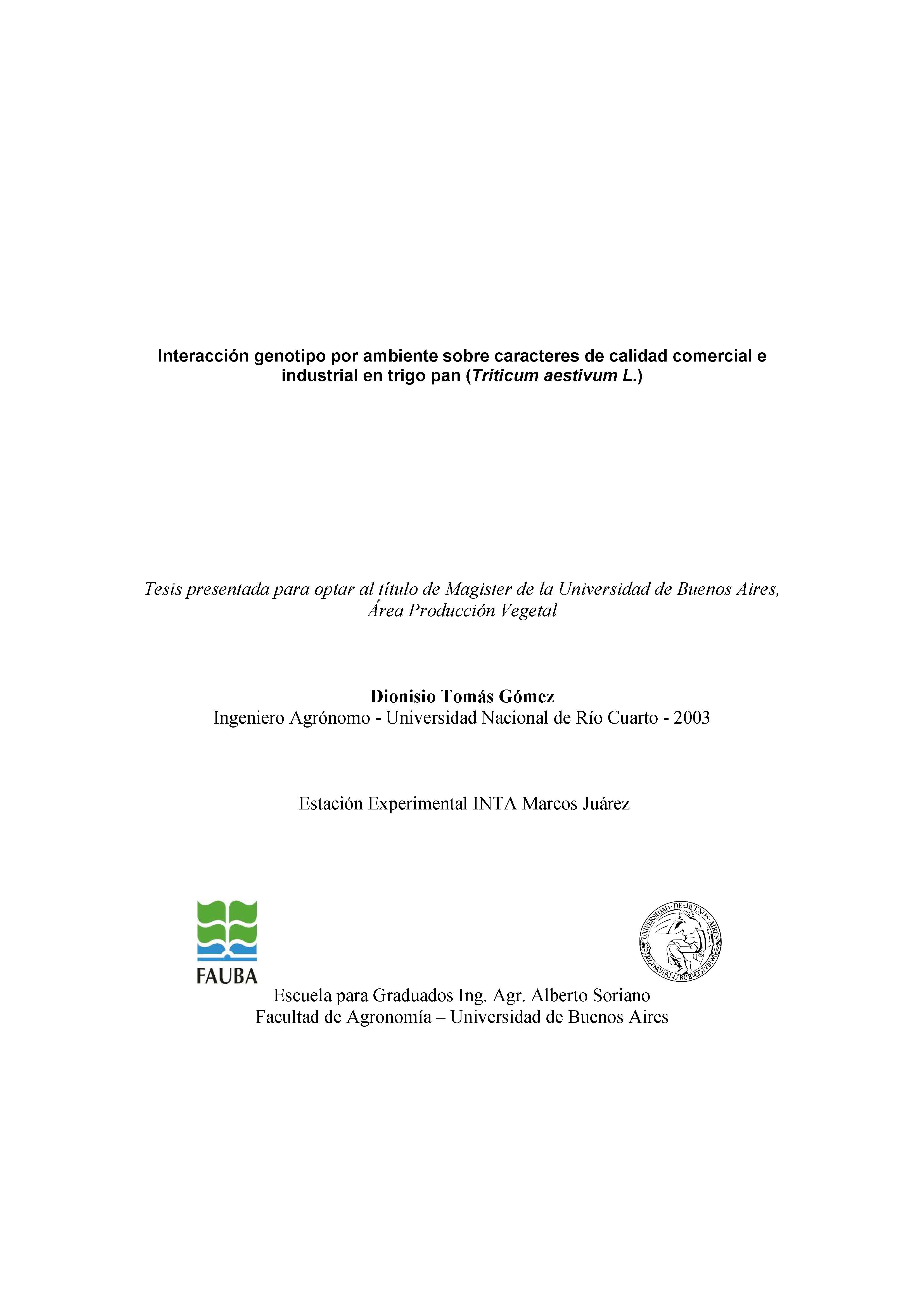View Item
- xmlui.general.dspace_homeCentros Regionales y EEAsCentro Regional CórdobaEEA Marcos JuárezTesisxmlui.ArtifactBrowser.ItemViewer.trail
Interacción genotipo por ambiente sobre caracteres de calidad comercial e industrial en trigo pan (Triticum aestivum L.)
Abstract
El genotipo (G), el ambiente (A) y la interacción G x A pueden influir de manera diferente sobre las característica que definen la calidad comercial e industrial de trigo pan. Los objetivos de esta tesis fueron: 1) Caracterizar el rendimiento y a sus componentes en cultivares de trigo pertenecientes a diferentes grupos de calidad, expuestos a ofertas de nitrógeno contrastantes. 2) Estudiar el impacto de distinta disponibilidad de nitrógeno sobre los
[ver mas...]
El genotipo (G), el ambiente (A) y la interacción G x A pueden influir de manera diferente sobre las característica que definen la calidad comercial e industrial de trigo pan. Los objetivos de esta tesis fueron: 1) Caracterizar el rendimiento y a sus componentes en cultivares de trigo pertenecientes a diferentes grupos de calidad, expuestos a ofertas de nitrógeno contrastantes. 2) Estudiar el impacto de distinta disponibilidad de nitrógeno sobre los componentes fisiológicos del llenado de los granos (i.e tasa y duración) en distintaas variedades de trigo pan y su posible efecto sobre los parámetros de calidad. 3) Caracterizar y cuantificar la interacción genotipo por ambiente sobre la expresión de los parámetros que determinan el rendimiento y la calidad comercial e industrial del trigo pan en ambientes con diferentes disponibilidades de nitrógeno. Se realizaron ensayos en dos localidades, durante dos años, utilizando seis variedades de distinta aptitud panadera (2 de cada grupo de clasificación por grupo de calidad -GC-), aplicando cuatro tratamientos de fertilización nitrogenadas. Se evaluó el efecto genético, ambiental y la interacción G x A, sobre el rendimiento y sus componentes, el peso de los granos y sus componentes y sobre los parámetros de calidad comercial e industrial. Los resultados mostraron que el rendimiento y sus componentes (número de granos, biomasa aérea, eficiencia de uso de la radiación interceptada acumulada) fueron afectados principalmente por el ambiente y el manejo nutricional dentro de de cada ambiente. Para el peso de los granos y sus componentes (tasa y duración) el efecto del manejo del nitrógeno no fue importante, aunque sí lo fue el efecto genotipo. Para los parámetros de calidad el efecto genotipo fue más importante solo para la tenacidad, mientras que el peso hectolítrico, gluten húmedo, fuerza panadera, la relación de equilibrio (P/L) y volumen de pan fueron modificados principalmente por el efecto ambiente no manejable como son el año y la localidad, en tanto la proteína fue afectada principalmente por el factor ambiental asociado al manejo nutricional. La interacción GxA fue el efecto que explicó en mayor medida las variaciones de rendimiento de harina, absorción de agua y tiempo de amasado. La fuerte interacción GxA observada para la mayoría de los parámetros de calidad determinó que variedades de un determinado GC cambien de grupo asociado principalmente a factores ambientales como la localidad y el año, mientras que el manejo nutricional tuvo un impacto menor
[Cerrar]
The genotype (G), the environment (A) and the GxA interaction affects the parameters that define bread wheat commercial and industrial quality. The objectives of this thesis were: 1) To analyse the yield and yield components in commercial wheat
genotypes classified by different aptitude for commercial and industrial quality, 2) To analyse the incidence of different nitrogen rates on grain weight and the physiological attributes that determine the final
[ver mas...]
The genotype (G), the environment (A) and the GxA interaction affects the parameters that define bread wheat commercial and industrial quality. The objectives of this thesis were: 1) To analyse the yield and yield components in commercial wheat
genotypes classified by different aptitude for commercial and industrial quality, 2) To analyse the incidence of different nitrogen rates on grain weight and the physiological attributes that determine the final grain weight and 3) To study the GxA interaction on the attributes that determine the commercial and industrial grain quality in bread wheat. Experiments were carried out in two different sites, during two consecutive years, combining six wheat varieties (two of them belonging to each of the three different
groups of quality –GC-), and four different nitrogen availabilities. The effect of G, A and GxA were evaluated on yield and its components, weight of grains and its components as well as on the commercial and industrial quality parameters. Results showed that yield and its components (grain number, aerial biomass, radiation use efficiency and accumulated intercepted radiation) were mainly affected by the environment and nutritional management within each environment. Average grain
weight and its components (rate and duration of grain filling) were not affected by nitrogen supply, although genotype effects were found. Genotype effects were found to be significant only for dough tenacity while average grain weight, wet gluten, baking strength, tenacity and extensibility of dough relationship and loaf volume were mainly modified by non-manageable environmental effects, such us year and location. Protein content was mainly affected by nutritional management. Genotype by environment
interaction mainly explained variations for flour yield, water absorption and mixing time. The strong GxA found for most of the quality parameters studied determined that wheat varieties belonging to a particular quality group could change to another GC due to environmental factors like location and year, while nutritional management had low impact.
[Cerrar]

Author
Director de Tesis
Miralles, Daniel Julio (director);
Descripción
Tesis para obtener el grado de Magister en área Producción Vegetal, de la Universidad de Buenos Aires, en 2011
Date
2011-08
Editorial
Facultad de Agronomía, Universidad de Buenos Aires
Formato
pdf
Tipo de documento
tesis de maestría
Palabras Claves
Derechos de acceso
Abierto
 Excepto donde se diga explicitamente, este item se publica bajo la siguiente descripción: Creative Commons Attribution-NonCommercial-ShareAlike 2.5 Unported (CC BY-NC-SA 2.5)
Excepto donde se diga explicitamente, este item se publica bajo la siguiente descripción: Creative Commons Attribution-NonCommercial-ShareAlike 2.5 Unported (CC BY-NC-SA 2.5)


